San Marino Video
Cultural Sensitivities: Understanding Local Norms in San Marino
San Marino, one of the world’s smallest and oldest republics, is a landlocked microstate surrounded by Italy. With its rich history and unique cultural heritage, it is essential for visitors to understand and respect the local norms and sensitivities. This article aims to provide a comprehensive guide to cultural sensitivities in San Marino, ensuring a positive and respectful experience for travelers.
Geographical and Historical Overview
San Marino, also known as the Most Serene Republic of San Marino, is located on the eastern side of the Apennine Mountains. It covers an area of just over 61 square kilometers and has a population of approximately 33,000 people. The republic is divided into nine municipalities, each with its distinct character and attractions. San Marino’s history dates back to the 4th century AD when a Christian stonemason, Saint Marinus, founded a small community atop Mount Titano.
- Mount Titano: Mount Titano is the highest peak in San Marino and offers breathtaking panoramic views of the surrounding landscapes. It is home to the historic center of San Marino, a UNESCO World Heritage Site.
- Three Towers of San Marino: The Three Towers, namely Guaita, Cesta, and Montale, are iconic landmarks of the republic. These medieval fortresses symbolize the strength and independence of San Marino.
- Basilica di San Marino: The Basilica di San Marino is an impressive neoclassical church located in the heart of the capital city. It houses the relics of Saint Marinus and is an important pilgrimage site.
- Piazza della Libertà: Piazza della Libertà is the main square in San Marino and serves as a focal point for social gatherings and events. It is surrounded by historic buildings, cafes, and shops.

Etiquette and Social Customs
Understanding the local etiquette and social customs is crucial when visiting San Marino. Here are some key points to keep in mind:
- Greetings: When meeting someone, it is customary to greet them with a handshake and maintain eye contact. A simple “Buongiorno” (good morning) or “Buonasera” (good evening) is appropriate.
- Respecting Personal Space: San Marino has a culture that values personal space. It is important to maintain an appropriate distance when engaging in conversations or interactions.
- Dress Code: San Marino has a relatively conservative dress code. It is advisable to dress modestly, especially when visiting religious sites or attending formal events.
- Punctuality: Being punctual is highly valued in San Marino. It is considered respectful to arrive on time for appointments, meetings, or social gatherings.

Cuisine and Dining Etiquette
San Marino offers a delightful culinary experience influenced by both Italian and regional traditions. Here are some insights into the local cuisine and dining etiquette:
- Traditional Dishes: Sample traditional dishes such as torta tre monti (a layered chocolate and hazelnut cake), passatelli (a type of pasta), and piadina (a thin Italian flatbread).
- Wine Culture: San Marino has a long tradition of winemaking. Don’t miss the opportunity to taste the local wines, including Sangiovese and Biancale.
- Table Manners: When dining in San Marino, it is customary to wait for the host to begin eating before you start. It is also polite to keep your hands visible on the table during the meal.
- Tipping: Tipping is not mandatory in San Marino as a service charge is often included in the bill. However, leaving a small tip for exceptional service is appreciated.
Art and Cultural Heritage
San Marino is renowned for its rich cultural heritage and vibrant art scene. Here are some highlights of the art and cultural attractions in San Marino:
- Museo di Stato: The Museo di Stato is the national museum of San Marino and houses a diverse collection of art and historical artifacts. It offers insights into the republic’s history and culture.
- Palazzo Pubblico: The Palazzo Pubblico is the seat of the government and houses the Council Chamber and various administrative offices. It is an architectural gem with beautiful frescoes.
- San Marino International Music Festival: The San Marino International Music Festival is a renowned annual event that showcases classical music performances by international artists.
- Antique Markets: San Marino hosts regular antique markets where visitors can find unique collectibles, vintage items, and traditional crafts.

Religious Customs and Traditions
Religion plays a significant role in the lives of many residents of San Marino. Here are some important religious customs and traditions to be aware of:
- Catholicism: The majority of San Marino’s population follows Catholicism. Visitors should respect religious sites, dress modestly, and behave appropriately when visiting churches.
- Religious Festivals: San Marino celebrates various religious festivals throughout the year, including the Feast of Saint Marinus and the Feast of the Assumption. These events often involve processions and special ceremonies.
- Mass Attendance: Attending Sunday Mass is an important tradition for many locals. Visitors are welcome to participate respectfully or observe from a distance.
- Religious Symbols: It is important to treat religious symbols and artifacts with respect. Avoid touching or taking photographs without permission, especially in sacred spaces.
Environmental Awareness
San Marino takes pride in its natural beauty and environmental sustainability. Visitors should be mindful of the following environmental considerations:
- Waste Management: San Marino has a well-organized waste management system. It is essential to follow the designated recycling and waste disposal guidelines.
- Nature Conservation: San Marino is home to several protected areas and nature reserves. Visitors should respect the environment, avoid littering, and stay on designated trails.
- Water Conservation: San Marino encourages responsible water usage. Be mindful of water consumption and follow any water-saving measures implemented by accommodations.
- Public Spaces: Keep public spaces clean and tidy. Dispose of trash in designated bins and respect the natural surroundings.
Conclusion
By understanding and respecting the cultural sensitivities and local norms in San Marino, visitors can have a meaningful and enjoyable experience in this unique microstate. From appreciating the historical landmarks to savoring the local cuisine, embracing the customs and traditions of San Marino enhances the overall journey.
References
– “Visit San Marino” (visitsanmarino.com)
– “San Marino – Cultural Etiquette” (culturecrossing.net)
– “San Marino” (worldtravelguide.net)
– “San Marino: Religion” (britannica.com)


